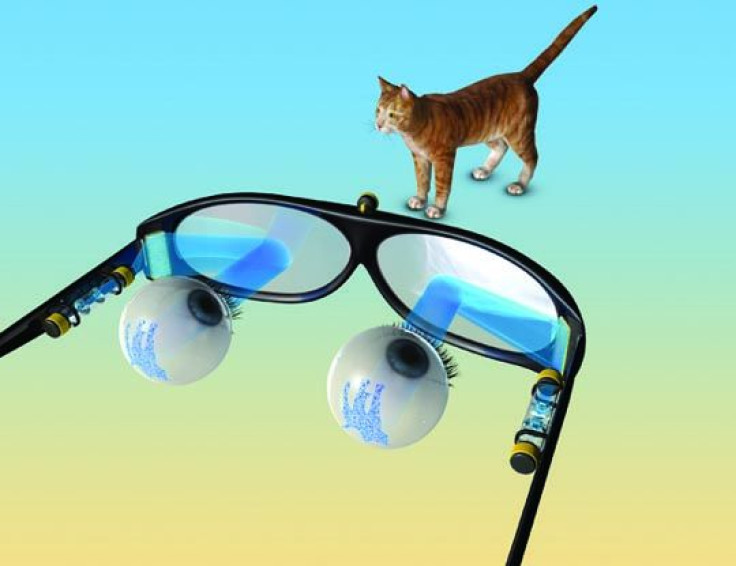Hologram Vision Technique May Restore Sight to the Blind

Holograms may soon be used to help people with damaged eyes see again.
Biomedical researchers at the Technion-Israel Institute of Technology in Israel are testing the ability of a new holographic technique to artificially stimulate retinal cells in the eye - a process that may lead to bionic vision restoration.
Blindness is often caused by conditions like retinitis pigmentosa, an inherited disease in which degrading light-sensing cells in the retina cause blindness.
One in 4,000 people in the United States are affected by retinitis pigmentosa, and research on restoring vision can potentially help tens of thousands of Americans see again.
The scientists hope that computer-generated holograms can be used along with optogenetics, a rapidly growing field of research that uses gene therapy to deliver light-sensitive proteins to damaged cells in the retina.
"The basic idea of optogenetics is to take a light-sensitive protein from another organism, typically from algae or bacteria, and insert it into a target cell, and that photosensitizes the cell," explained Dr. Shy Shoham, who led the study.
If retinal nerve cells are primed by gene therapy that uses these light-sensitive proteins, they can then be gradually activated by rapid bursts of light.
However, optogenetic research still needs work. According to Dr. Shoham, researchers are still looking for the ideal way to deliver the pulses of light so that the damaged retina can learn to respond in an almost normal way.
In a paper published in the Feb. 26 issue of Nature Communications, the researchers led by Dr. Shoham explain how light from computer-generated holography can be used to stimulate genetically repaired cells in mouse retinas.
They say that the key is to use a light stimulus that is intense, precise, and can trigger activity across a variety of cells at the same time.
"Holography, what we're using, has the advantage of being relatively precise and intense," Shoham said. "And you need those two things to see."
The researchers sifted through other options to stimulate the retinal cells before turning to holography, including laser deflectors and the digital displays used in portable projectors. Both methods had limitations.
According to Dr. Shoham, digital light displays can stimulate lots of nerve cells at once, "but they have low light intensity and very low light efficiency." Genetically repaired cells are less sensitive to light than healthy retinal cells, so a bright light source like a laser is the ideal stimulation for them.
However, lasers, while intense, are so precise that they cannot provide the parallel projection that would simultaneously stimulate all the retinal cells would be necessary to allow the brain to create a complete picture.
"Holography is a way of getting the best of both worlds," said Dr. Shoham.
Dr. Shoham's team has tested the potential of holograms to stimulate retinal cells in the lab, and have done some preliminary research with holograms on living mice with damaged retinal cells.
The results show that holograms can provide reliably precise, intense, and simultaneous stimulation of multiple retinal cells at millisecond speeds.
Eventually, researchers hope to use this hologram vision technology to develop a bionic vision prosthetic eyepiece that a person can wear to turn visual scenes into light patterns that stimulate the genetically altered cells.
At this point, Dr. Shoham believes that a functioning holographic prosthesis in humans is far in the future, but his team is exploring other ways to activate damaged nerve cells aside from optogenetics.
One possible method they are working with uses ultrasound to activate retinal and brain tissue, instead of light.
Shoham also sees other uses for holography, saying that it "also provides a very interesting path toward three-dimensional stimulation, which we don't use so much in the retina, but is very interesting in other projects where it allow us to stimulate 3-D brain tissue."
This research builds on other developments in retinal research, like the announcement made by the U.S. Food and Drug Administration earlier this month that they approved the first artificial retina and retinal prosthesis. That retinal device works differently than Dr. Shoham's study at Technion, with a glasses-like prosthetic that transmits light signals to an artificial "retina" consisting of electrodes.
The Technion hologram vision research has been praised by other vision researchers.
"I think Shy's lab is very smart to pursue many methods of restoring vision," said Eyal Margalit, a retinal disease specialist at the University of Nebraska Medical Center.
Dr. Margalit said in a statement that other cutting-edge methods that may help restore vision include using stem cells to replace damaged retinal cells, transplanting entire layers of healthy retinal cells, and in some cases bypassing the eye completely and directly stimulating the visual cortex of the brain to restore lost vision.



























